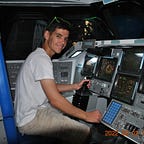Day 6: The Science Behind Free-Return Trajectory
The Free-return trajectory was an emergency flight-profile designed to bring the Apollo spacecraft, and its astronauts, back to Earth’s atmosphere automatically in case of a failure. The process would be used in Apollo 13, where the CSM (which was feared too damaged to burn its engine) was not available for large course corrections.
The maneuver uses what's called a gravity assist maneuver: a spacecraft uses the gravity of a large celestial body to gain or loose momentum, either increasing their orbital speed or decreasing it respectively.
Voyagers 1 and 2 both used gravity assist maneuvers to propel themselves to speeds in excess of 15km/s as shown in the animation.
This illustration shows it well. It is essentially adding the velocity of the planetary body to the velocity of the spacecraft. No rocket on Earth can be built big enough to send a spacecraft at 16km/s, so gravity assists are useful and necessary.
The maneuver can also be used to slow down.
For Apollo, the free-return trajectory would take the spacecraft in front of the moon’s path, thus slowing the craft down.
Of course, when this maneuver is used, there will not be a lunar landing (since you have to enter Lunar Orbit for the landing), so only 2 missions used Free-Return: Apollo 8 (the human trial run of a lunar free-return) and Apollo 13 (who, of course, had to use Free-return in the event of the failure).
If you are still confused about Free-Return Trajectory, watch this video by Scott Manley https://www.youtube.com/watch?v=lIORB7svhaA.
